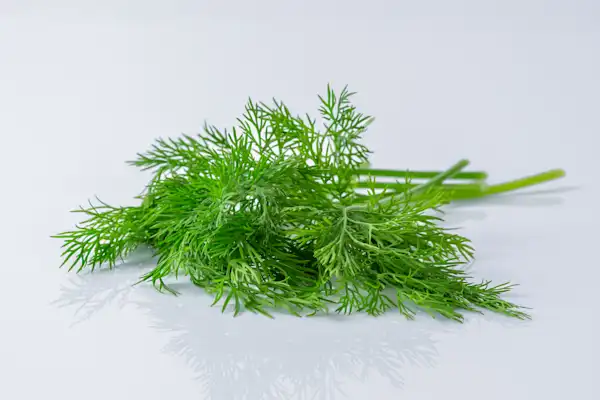Acceda a la base de datos First Foods® en Solid Starts App.
Leer másDill
Hierba/Especia
Sugerencia de edades
6 meses
Alto contenido de hierro
No
Alérgeno común
No

When can babies have dill?
Dill may be introduced as soon as baby is ready to start solids, which is generally around 6 months of age.
Dill comes from the lands around the Mediterranean Sea, where it has long been cultivated for its medicinal and culinary uses. Both its seeds and delicate lacy fronds are edible, lending a citrusy taste and fresh aroma to sauces, soups, stews, and more.
How do you serve dill to babies?
Cada bebé se desarrolla a su propio ritmo, y las sugerencias que ofrecemos sobre cómo cortar o preparar determinados alimentos son generalizaciones para una amplia audiencia.
6 months old +:
Finely chop fresh dill and incorporate into age-appropriate dishes for baby, like a dressing for cooked vegetables or a sauce for meat. As long as the stem of the plant is soft, you can finely chop the stem along with the leaves. If the stem has gotten woody and tough, remove the leaves from the stem before preparing. Alternatively, use dried dill or dill weed powder to flavor food.
12 months old +:
Use fresh, dried, or powdered dill weed as you normally would in dishes, even if a recipe calls for larger pieces of dill fronds. Just keep in mind that any larger pieces of dill may cause toddlers to gag or cough a little. Keep an open cup with water or milk on hand and encourage the toddler to take a sip if a bit of dill gets uncomfortable.
Videos
Is dill a choking hazard for babies?
No. Dill presents a low risk when safely prepared for a child’s age and developmental ability, though, in theory, an individual could choke on any food. To reduce the risk, prepare and serve dill in an age-appropriate way as described in the How to Serve section. As always, make sure you create a safe eating environment and stay within an arm’s reach of baby during meals.
Learn the signs of choking and gagging and more about choking first aid in our free guides, Infant Rescue and Toddler Rescue.
Is dill a common allergen?
No. Allergies to dill are not common, but rare cases have been reported, some of which were severe.
Individuals with Oral Allergy Syndrome (also known as pollen food allergy syndrome), particularly those who are allergic to birch or mugwort pollen and/or sensitive to foods within the Apiaceae family (such as carrot, celery, coriander, cumin, and fennel), may also be sensitive to dill as it is part of the Apiaceae family. Oral Allergy Syndrome typically results in short-lived itching, tingling, or burning in the mouth and is unlikely to result in a dangerous reaction. Cooking dill may help minimize the reaction.
Dill has also been associated with contact rashes from household and occupational exposure, along with phytophotodermatitis (a hyperpigmented, occasionally blistering rash that develops on skin exposed to both the plant allergen and UV light). If baby has sensitive skin and a tendency to develop contact rashes, be sure to wash the child’s hands and face after prolonged contact with dill.
As you would when introducing any new food, start by offering a small quantity for the first few servings. If there is no adverse reaction, gradually increase the quantity over future meals.
Is dill safe for babies?
Yes, dill is generally recognized as safe in amounts typically used in cooking. Dill essential oils should be avoided for babies, as research on their use and safety in babies and young children is limited.
Is dill healthy for babies?
Yes. Dill offers small amounts of a variety of vitamins, minerals, and fiber, including a dash of vitamin C. It also contains a number plant compounds like phenolic acids and flavonoids, which may offer digestion-supporting, antimicrobial, and antioxidant properties.
¿Es necesario tener una trona/silla alta?
Si bien una silla alta puede ayudar a crear un entorno seguro para comer, existen formas alternativas para que el/la bebé coma de forma segura, así como sostenerlo/a en tu regazo o sentarse juntos en el suelo. Para obtener más información, consulta nuestra Guía detallada de sillas altas para bebés.
¿Cuáles son las señales de que mi bebé está listo/a para comenzar sólidos?
Las señales incluyen poder sentarse con mínimo apoyo, mantener la cabeza erguida y poder alcanzar y agarrar un objeto y llevárselo a la boca con éxito mientras está sentado/a. El/la bebé también debe mostrar interés en comer y en observar comer a sus cuidadores. Para ejemplos visuales de bebés que están listos y que no, visita nuestro artículo sobre señales de preparación.
Nuestro equipo
Escrito por
Consejos de expertos directo a tu bandeja de entrada
¡Suscríbete y recibe correos semanales con recetas, consejos y más!
Copyright © 2025 • Solid Starts Inc





